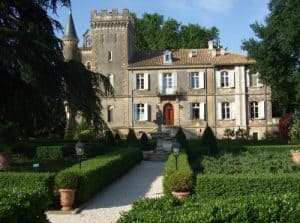Although a rather small Languedoc village, Aniane has a world-wide reputation as the home of Mas de Daumas-Gassac where owner Aimé Guibert (who sadly died in 2016 aged 91) challenged the traditional wine bureaucracy by making top quality wines outside the very restrictive Appellattion Controllée system – and then the locals saw off an attempt by a large multinational to buy up a significant chunk of the local vineyards in order to make some bland, branded wine.
Importantly the village lies in the heart of the Languedoc vineyards about 40km North East of Montpellier (34 Herault, Occitanie) Hence it makes an ideal focus for the substantial Aniane Wine Fair (Salon des Vins) on the weekend of 17 – 19 July 2020 – several dozen wine makers from Aniane and surrounding villages (including Daumas Gassac) will be attending, including one of my favourties – the Mas de la Serranne. where Isabelle & Jean-Pierre Venture make some excellent Coteaux du Languedoc AC wines blending traditional Languedoc with Rhône grape varietals which produce intense. but smooth, herby red wines.![]()
There is also a Christmas Market 14 – 15 December 2019 see www.festivaldesvinsdaniane.com/
For more info see Aniane Wine Fair

Stay in a self-catering apartment/gite at the wine estate of Chateau Capion in the village.
In 1970 : Whilst searching for a family home in the Hérault hinterland, Véronique and Aimé GUIBERT fell under the spell of an abandoned farmhouse nestling on the bend of a pine bordered lane. Owned by the DAUMAS family, it was in the heart of a splendid, unspoilt valley through which runs the GASSAC river.Strangers to the world of the vine, but entranced with ‘mother earth’ Aimé and Véronique debated what to grow : maize, olives, vines …? But they were fortunate in their fellow Aveyron friend, Professor Henri Enjalbert, a geologist specialising in the relationship between land and grapes and author of several works including a book on the ‘origin of quality’.
In 1971 :Professor Enjalbert first visited Daumas Gassac. After only a day walking round the Domaine he raved about the ice age scree covered land likening it to the best soil in Burgundy’s Côtes d’Or. ‘It’s quite possible to make a Grand Cru here’ he told them. ‘But it would probably take 200 years for it to be recognized and accepted as such!!!’. Enjalbert’s words ‘Grand cru’ acted as though someone had thrown down a gauntlet for ethnologist and Irish specialist, Véronique, and Aimé, a tanner and glove maker. They were quick to pick it up. As Henri Enjalbert explained, the potential for an outstanding red wine was enhanced by underground cold water springs and the influence of the surrounding mountain which created a true micro-climate with a touch of humidity reminiscent of the Medoc.
In 1972 : Planting of un-cloned Cabernet Sauvignon vines. The Guibert mantra is that uniformity is the enemy of quality. They tracked down some vines propagated from cuttings taken in some of the great Bordeaux properties during the 1930s & 1940s. And, as in the best Medoc chateaux, their choice was based on quality and diversity rather than on yield and disease resistance. www.daumas-gassac.com
Discover more from FrenchDuck.com
Subscribe to get the latest posts sent to your email.